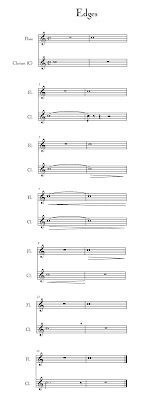
Some people hear sounds as colours, synaesthesia; I don't have that particular pleasure, but I do hear sounds as possesed by vivid textures. Some sounds are smooth, whether with the depth of melted chocolate or insubstantial like fog. Each sound has an edge, but some edges are hard to locate, let alone to get a grip on, while the best-defined edges crash and crunch and crackle. Sometimes the most striking edge of a sound is that at the release, where it may disappear into silence or terminate efficiently and sharply defined by silence (which may have a hard edge of its own) or the next sound. Conducting can be a marvelously tactile experience -- when it goes well, you can convince yourself that your body is actually pushing those wave fronts around, and each measured beat acquires its own hard edge in physical space.
It's useful to practice composing transitions, from this to that (or from here to there, if you prefer a spatial metaphor), and edges are essential to this. Perhaps the best practice for transitions was tape splicing, back in the days when one spliced tape. (It's of some significance, perhaps, that audio tape editing was a skill largely overtaken from film editing with its origins as a silent medium; of course, one could also argue that the aesthetics of film editing owe much to music, and opera in particular, making a sweet circle of influence). Joints between tape fragments could be vertical, a straight cut through the tape, directly from one fragment to the next (a butt joint in joinery parlance) or they could be diagonal, gradually going from one thing to the next, rather than suddenly. Or there could be space -- silence -- between the fragments, silence have articulative power of its own. Ezra Pound, in his The Theory of Harmony, argued reasonably that any sound could follow another provided the time between the two was of sufficient length, and that the more different the two sounds were, the greater the distance. This is, of course, a rough formula for making smooth transitions, and music isn't always smooth, thank Ives, and turning Mr Pound's formula on edge, is often just the thing for waking the bored and complacent and breaking the illusionary peace of a musical moment turned dull.
No comments:
Post a Comment